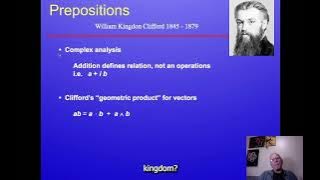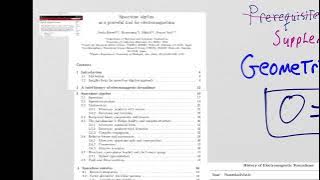Geometric algebra
In mathematics, a geometric algebra (also known as a real Clifford algebra) is an extension of elementary algebra to work with geometrical objects such as vectors. Geometric algebra is built out of two fundamental operations, addition and the geometric product. Multiplication of vectors results in higher-dimensional objects called multivectors. Compared to other formalisms for manipulating geometric objects, geometric algebra is noteworthy for supporting vector division and addition of objects of different dimensions. The geometric product was first briefly mentioned by Hermann Grassmann, who was chiefly interested in developing the closely related exterior algebra. In 1878, William Kingdon Clifford greatly expanded on Grassmann's work to form what are now usually called Clifford algebras in his honor (although Clifford himself chose to call them "geometric algebras"). Clifford defined the Clifford algebra and its product as a unification of the Grassmann algebra and Hamilton's quaternion algebra. Adding the dual of the Grassmann exterior product (the "meet") allows the use of the Grassmann–Cayley algebra, and a conformal version of the latter together with a conformal Clifford algebra yields a conformal geometric algebra providing a framework for classical geometries. In practice, these and several derived operations allow a correspondence of elements, subspaces and operations of the algebra with geometric interpretations. For several decades, geometric algebras went somewhat ignored, greatly eclipsed by the vector calculus then newly developed to describe electromagnetism. The term "geometric algebra" was repopularized in the 1960s by Hestenes, who advocated its importance to relativistic physics. The scalars and vectors have their usual interpretation, and make up distinct subspaces of a geometric algebra. Bivectors provide a more natural representation of the pseudovector quantities in vector algebra such as oriented area, oriented angle of rotation, torque, angular momentum and the electromagnetic field. A trivector can represent an oriented volume, and so on. An element called a blade may be used to represent a subspace of and orthogonal projections onto that subspace. Rotations and reflections are represented as elements. Unlike a vector algebra, a geometric algebra naturally accommodates any number of dimensions and any quadratic form such as in relativity. Examples of geometric algebras applied in physics include the spacetime algebra (and the less common algebra of physical space) and the conformal geometric algebra. Geometric calculus, an extension of GA that incorporates differentiation and integration, can be used to formulate other theories such as complex analysis and differential geometry, e.g. by using the Clifford algebra instead of differential forms. Geometric algebra has been advocated, most notably by David Hestenes and Chris Doran, as the preferred mathematical framework for physics. Proponents claim that it provides compact and intuitive descriptions in many areas including classical and quantum mechanics, electromagnetic theory and relativity. GA has also found use as a computational tool in computer graphics and robotics. (Wikipedia).



















